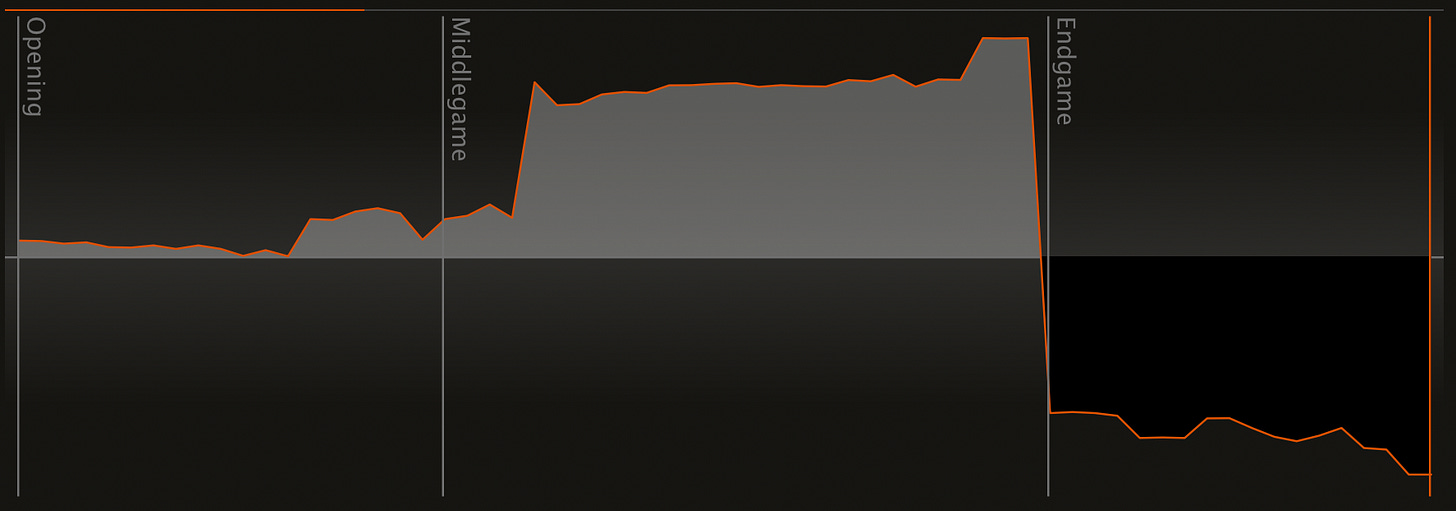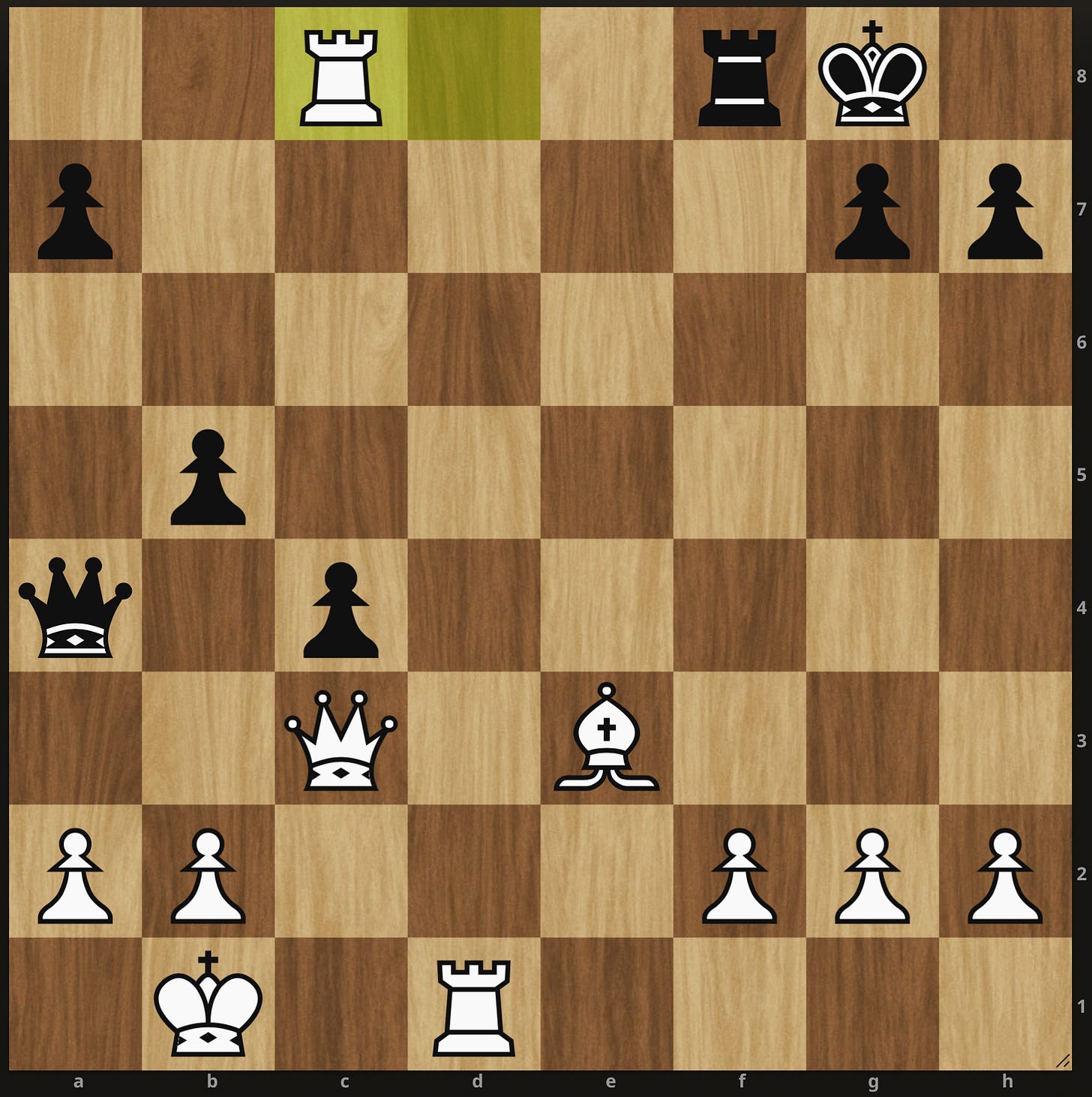Welcome back to Analyze This! This is a series where I analyze my classical games trying to improve. It is my belief that the best way for adults to improve is to play slow games and then analyze them.
At least that was the idea… and then I played this game and almost quit chess.
You’ll see the winning-to-losing blunder when I captured on c8 instead of f8. Just look at this eval swing! Good grief!
I was so mad at myself that I was on tilt for about 24 hours. I seriously considered taking a break from chess. It’s one thing to miss a winning move, that happens. It’s entirely another thing to play the only losing move in the position. For someone who’s spent a lot of time on chess, I found this completely unacceptable.
Life goes on however, and I needed process my loss. That led me to write my most popular piece so far, on the origin of blunders. The other good thing was I noticed some patterns in my games (as well as tactics puzzles).
First, I sometimes miss my opponent’s resources and am only focused on my moves. It’s not like my opponent is just going to sit there and let me do what I want. I need to consider their most resilient moves, even if it looks totally winning for me.
Second, I learned that many of my blunders happen later in the game. I suspect that I’m just getting mentally tired and need a short break (or some chocolate). After every 1-2 hours it’s probably smart for me to step away from the board for a few minutes and reset. After that I can come back fresh to the position.
With that, let’s get to the game! There was a lot to learn (even before the blunder).
I knew my opponent was playing Black and we’d get an Italian game. This opening line is well known, but there are several forcing lines including the Evan’s Gambit, the “trendy” Dubov Gambit, and the Center Attack. I have played all of these lines at sometime or another. Recently however I’ve centered on the idea that I need to understand the positions that I get out of the opening. The Dubov Gambit is very forcing, but some of the positions are really tricky. Instead, I planned on going with a variation on the Center Attack thanks to Magnus Carlsen bringing it back into favor.
1.e4 e5 2.Nf3 Nc6 3.Bc4 Bc5 4.c3 Nf6 5.d4 exd 6.e5!
Technically a gambit as White is down a pawn, but it will be reclaimed soon. Black’s best move is 6…d5 pushing the bishop off the a2-g8 diagonal. 7.Bb5 (pinning the c6 knight) is white’s move and then Black has a choice. Where to put the knight on f6?
By far the best option is Ne4 as played by Nepomniachtichi, So, Giri, and others against Carlsen in this line. My opponent chose 7…Nd7? which is a mistake.
After 8.cxd4 I got the pawn back and now I have strong center control with pawns on d4 and e5. Again, Black again has to make a choice - where to put the bishop on c5? I didn’t mind 8…Bb4+ as I’d get to play 9.Nc3, developing the knight. Even if Black had played 7…Ne4 and then 8…Bb4+ I’d simply plays 9.Bd2 (or Nbd2 which is also good) and continues with a strong pawn center and solid development. Largely due to that, Black often plays 8…Bb6 which my opponent did. We continued developing with 9.Nc3 0-0 10.Be3 (Nxd5 or 0-0 was better) and then my opponent played 10…f6? attacking the pawns. (Ne7 was better.)
This position seemed really good for White. All my minor pieces are active and are playing a role. The f pawn has moved, exposing the king. The d5 pawn is hanging and I always have the threat of Bxc6. I could so no reason to castle here as much as I wanted to complete development. Instead I played 11. Nxd5 fxe 12.Nxb6 (winning the bishop pair) and then Black played 12…exd4?? and my brain exploded.
This is a critical mistake. Black has blundered a piece and now White has the choice of which capture to choose next. However, just count with me all the potential checks and captures for White in this position
Checks: Qb3+, Bc4+
Captures: Bxc6, Nxa8, Nxc8, Nxd7, Bxd4, Nxd4, Qxd4
Threats: axb6, Nxb6, dxe3
I had spent maybe 4 minutes calculating before I played 11.Nxd5. In this position I thought for 7-8 minutes just trying to consider all the possible continuations. I’m up a piece already, but I wasn’t sure what was the most forcing. Given the list of possible one move captures and checks, I should have spent a lot more time here to be certain of the consequences. I didn’t even really considered the Nxa8 option (the best move) because I was stuck thinking through all the other possible moves. It was just nuts.
In the end I opted for the plan I could see and understand: 13.Nxd7 (threat of Nxf8 can’t be ignored) Bxd7 14.Nxd4 Nxd4 15.Bxd7 Qxd7 16.Qxd4 and White ends up a full piece. This is the exact line we played out.
White is winning here. To be fully transparent, I knew I was winning and I began to tighten up. My idea was simply “don’t screw up” and somehow try to bring the extra piece to bear. In hindsight now my plan should have been to trade queens and cement my advantage. Black’s best counterplay is with an active Queen.
From here Black tried to make sure I didn’t castle my king, so after 16…Qb5 I played 17.0-0-0 but Rac1 was probably better and the threat of 18.Qc4+ forcing the trade of queens cements the win. We played on with 17…c5 18.Qc3 c4 19.Rd4 Rac8 20.Rhd1 Qa4 21. Kb1? b5 22.Rd7! threatening mate on g7. All seemed going well for White.
Ok, so how did I lose this game? I could tell you it was by playing passively when I was ahead, or playing to “not lose”. However the truth is more painful. I just moved quickly without thinking it all the way through. I was certain that Black was forced to capture back…but it wasn’t true. I blundered by not considering the forcing moves available to Black. After 22…Rf7 23. Rd8+ Rf8 he was under no obligation to take back after 24.Rxc8??
If I had played 24.Rxf8+ and then followed with 25.Rd7 I’d likely win the game. But after 24…Qxc1+! I had gone from winning to losing. Just devastating.
The horror I felt once I realized my mistake was immense. I simply needed to do a blunder check. However, I didn’t (and often haven’t). For some reason “blunder check” just doesn’t trigger the right thoughts for me. So instead now I ask “What are my opponent’s resources?” For some reason when I ask that, I start looking. That’s at least a start.
The other thing is I will be sure to take mental breaks throughout a game to combat decision fatigue. Water, snacks, and mental rest are all needed to play well.
I am still just sick from this game. Happily, it didn’t take long to get the taste of the game out of my mouth. I had another game the very next day. More on that next time.
Thanks for reading! Would love to hear what you think of either this game or this series. Until next time, good luck with your chess!













True chess improvement only happens if you are able to get back to it after getting punched in the mouth. Having a lack of fear of losing and focusing more on improvement. Good of you to be able to bounce back so quickly (and I'm sure writing about it helps you to process).
When I have posted that chess can inflict intense emotional pain, I had the posted Vasquez type game in mind.